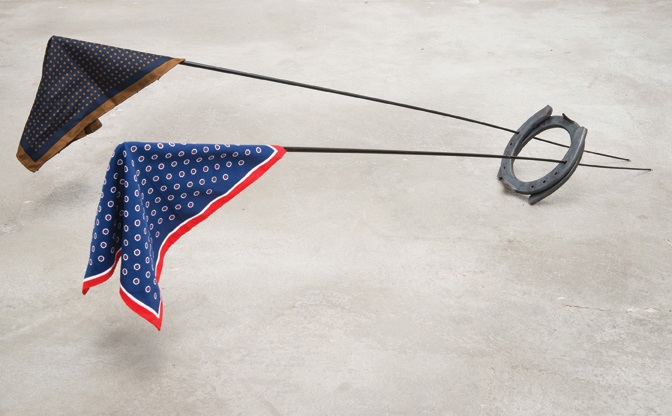« Reviews
Nino Cais: Teach Me How to Dance
Fridman Gallery - New York
By Kim Power
Nino Cais’ first solo show in North America at the Fridman Gallery asks Teach Me How to Dance, openly engaging the viewer to actively participate in the interpretation of a personally visual haiku of objects and their relational meanings. Cais, a Brazilian conceptual artist of humble beginnings, commenced his education in the Catholic priesthood, later switching to art as his chosen vocation and graduating from the Santa Marcelina University (FASM) in 2000. Winner of Acquisition Award at the 33rd Art Salon of Ribeirão Preto in São Paulo (2008), the National Prize by the Iberê Camargo Foundation (2008/2009) and participant in the 2012 São Paulo Biennial, Cais’ poetic works have been opening perceptual doors since 1998.
In his ground-breaking book, Phenomenology of Perception (1945) French philosopher Merleau-Ponty states, “Our perception ends in objects, and the object once constituted, appears as a reason for all the experiences of it which we have had or could have.” Relying on intuition, Cais collects, arranges and manipulates found images and objects, creating a resonating symbiosis of fragility and concrete existence while searching for a “tension that is caused by the strangeness of the combination of objects.” In one installation (Untitled, 2015), two horseshoes lain flat against each other on opposite sides are held diagonally on the floor by the insertion of two thin fishing rods, which in turn are draped on the ends by two kerchiefs. One would suppose that the weight of the iron shoes implies strength, yet it is the two slender rods that hold them up, the kerchiefs adding a visual yet physically insubstantial counterbalance.

Nino Cais, Untitled, 2015, horseshoes, fishing rods and kerchiefs, 11” x 53.5” x 5.” Courtesy of Fridman Gallery.
In spite of making a declaration to eschew narrative, the semantic memory of Cais’ past seems to have imbedded itself subconsciously in the symbolism of several works. Take, for instance, the draping of a Roman bust with a lavender colored cloth in one of Cais’ Untitled (2015) printed collages, which brings to mind the veiling of church statues during Passiontide. Then there’s the defacement of figures, such as Cais’ installation of three vintage photos of athletes, each face marked out with red oil paint (Untitled, 2015). Does it not denote a suggestion of iconoclasm? If so, is Cais denigrating the worship of sportsmen as heroes?
Cais likens his work to Lucio Fontana, artist/inventor of the concept Spazialismo in which Fontana cut canvases to create a dimensional space, but explains that, personally, he is trying to “create a subjective area in the object,” that is internalized by the viewer. Cais’ own face is covered with a ponytail in a single-channel video (Untitled, 2015) in which he imitates a horse’s trot by slapping his legs and tapping his feet in syncopated rhythm. While the denial of facial recognition might cause anxiety in some, Cais’ intention is to transcend the usual signifiers of emotion and, like his decontextualized objects, encourage new definitions of materiality. In this suppositional offering of reorganized material reality Cais seems to be taking a leap of faith that the viewer will find meaning, to which I ask, “Shall we dance?”
(April 29 - June 11, 2016)
Kim Power is a Bronx-based mixed-media artist and freelance writer. A graduate of the New York Academy of Art (2014), she regularly contributes to The Brooklyn Rail and Arte Fuse art blog.
Filed Under: Reviews



































Leave a Reply
You must be logged in to post a comment.